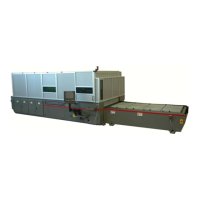9-5
EM-573 (N-04-18)
Stubborn deposits can be removed with an abrasive pad such as Scotch-Brite
®
, or in extreme cases with 240
grit wet-or-dry silicon carbide paper.
ENCODER MAINTENANCE
The laser system X and Y-axes have “open style” linear encoders that are covered by exible bellows. The
encoder scales require periodic inspection and cleaning to maintain reliable operation.
ENCODER CLEANING
The open construction allows access for cleaning the encoder scale. Clean the scale if axis motion is unstable.
No signal indicators will be present with the AMO encoders. Clean the scale if the axis motion is unstable or is
dirty.
If encoder scale cleaning does not correct motion instability or restore encoder signal strength, it may be
necessary to clean the X-axis Read Head optics. Cleaning the Read Head requires disassembly. Consult
CINCINNATI Laser Service before removing the Read Head.
The X-axis encoder scales are protected by a lacquer coating to help them tolerate handling and contamination.
Clean the scale with a soft, dry cloth. To remove oil and grease lms, lightly wet the cloth with Isopropyl alcohol
or h-Heptane solvent.
READ HEAD
ENCODER
SCALE
X-AXIS
Figure 9-6 X-axis Encoder Read Head with Air Nozzle Scale Purge
Do not use aggressive solvents (Acetone, Chlorinated Solvents, Benzene, Mentholated Spirits, etc.) to
clean X-axis encoder scales; aggressive solvents can damage the lacquer coating.
Clean the Y-axis scale with a soft, dry, lint-free cloth only.
Do not use aggressive mechanical cleaning techniques or solvents to clean the Y-axis encoder scale.
Debris accumulation is less likely on the Y-axis scale because of its vertical orientation. There are no air
purge nozzles or Read Head signal indicators on the Y-axis encoder.
Inspect the encoder scales monthly. Check for debris and/or grease migration from the linear bearings adjacent
to the scales. Clean the scales only as necessary.
OPTICS HANDLING AND CLEANING
The focusing lens, collimator, cover slides and the ber optic cable quartz block are the most critical components
in the beam delivery system. These optical elements are made of materials that transmit the laser beam instead
of absorbing it.
An unfortunate drawback of the optical materials, is that they are very easily scratched or chipped, and when
damaged, will absorb the beam. Foreign materials such as oil mist, dust, smoke, ngerprints, or water vapor
can cause the optic to absorb the energy of the beam. Any excess beam absorption by these optical elements

